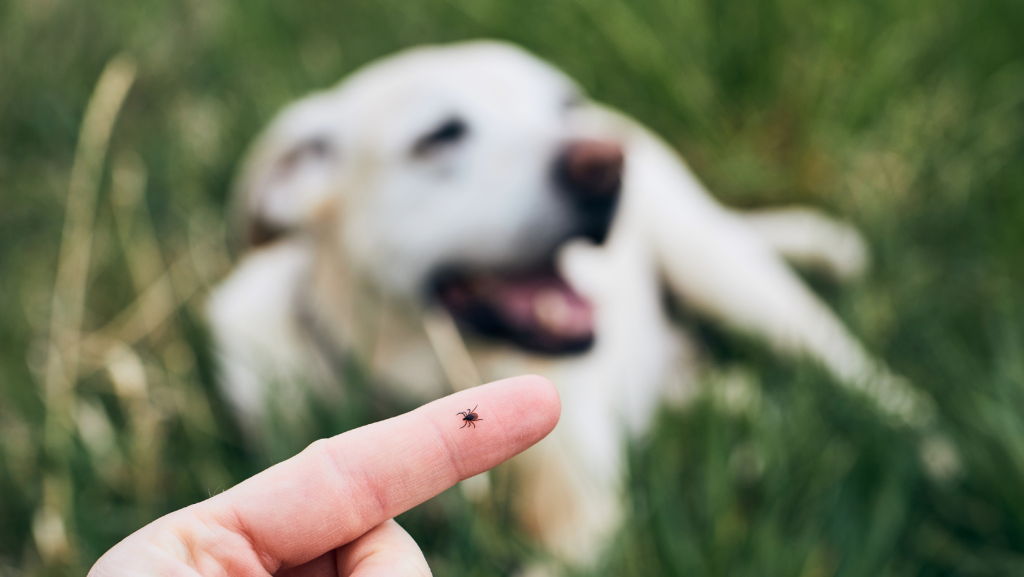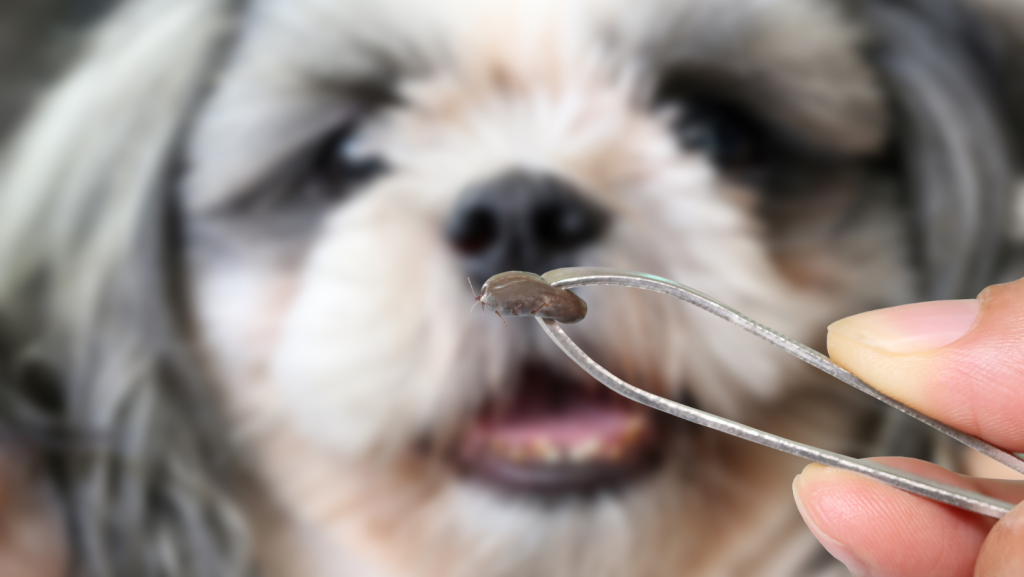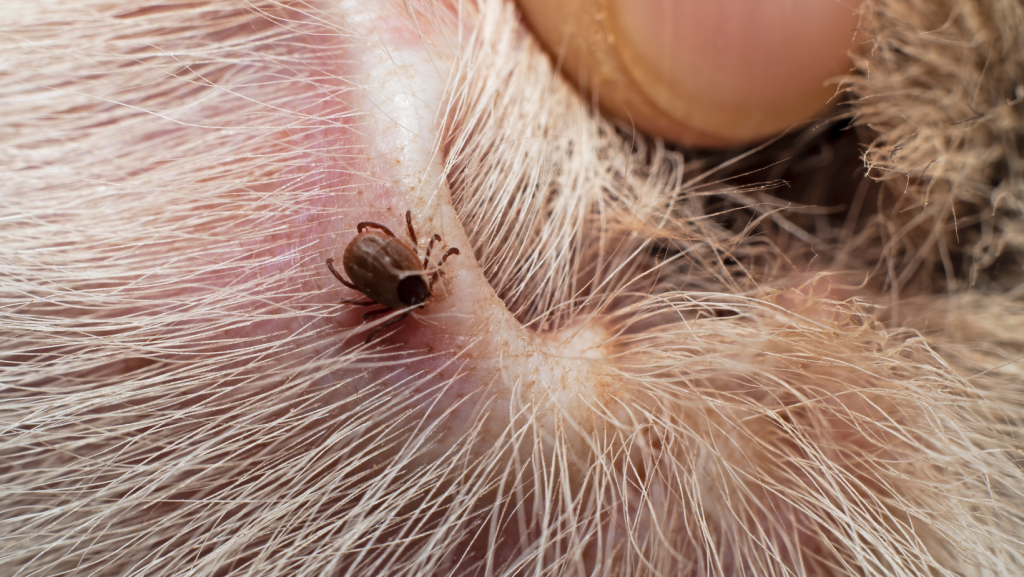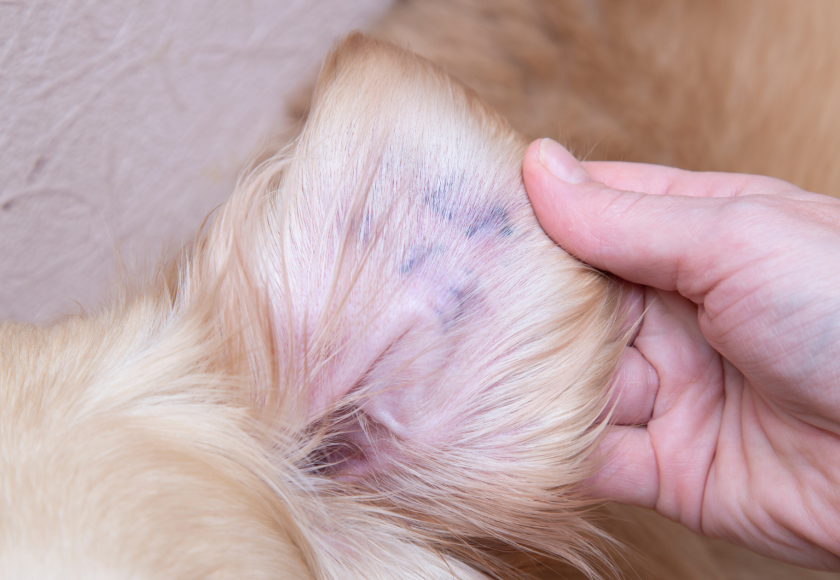Ticks are widespread throughout Lithuania. They are actually arachnids, not insects, and can range in size from 1 millimeter to 1 centimeter. Ticks are most commonly found in tall grass and bushy areas. Ticks bite dogs in order to feed. A tick bite is dangerous to dogs because of the diseases they carry.
Table of contents
Is there a certain time of year when my pet may be affected?
Ticks are most active in spring, early summer, and early fall. They are generally unaffected by cool weather and remain active at temperatures as low as -5 degrees Celsius. After winter, they can become active again on sunny days, even at sub-zero temperatures.
Why should you be concerned about tick bites on your dog?
The main reason for avoiding dog tick bites is that ticks act as carriers (spreaders) of infectious diseases.
In rare cases, dogs may develop bacterial infections or abscesses at the site of the tick bite. This is more likely if the tick was removed improperly and part of the tick remained in the skin.
Veterinarians at the Begemotas Veterinary Clinic in Vilnius recommend taking care of your dog’s health and protecting them from ticks. Remember – removing ticks from your dog’s skin does not protect them from disease.

Protection for dogs against tick-borne diseases
The best protection for dogs against ticks is prevention. There is a wide range of tick repellents available in modern veterinary medicine, but it is important to understand that all of these products work by their active ingredient entering the bloodstream and being eliminated from the blood by the kidneys and liver.
To protect dogs from tick-borne diseases, you can choose from drops, collars, tablets, and additional sprays. Each of these options has its own advantages, so it is important to choose the one that best suits your dog.
It is also worth knowing that dog ticks are dangerous to humans. If a tick comes home with your pet and bites a person, it can transmit an infection. Therefore, protection against ticks is important not only for the health of your pet, but also for the safety of the whole family.
Tick vaccine for dogs – a long-lasting injection for protection and convenience
A tick vaccine for dogs is one of the most important preventive measures to protect pets from dangerous diseases spread by ticks. Although this measure is often referred to as a “vaccine,” it is not actually a vaccine, but rather an injection containing long-acting antiparasitic substances. However, many owners refer to this form of protection as a vaccine, so it is important to know how it works and what its benefits are.
This injection is particularly suitable for dogs that spend a lot of time outdoors or in other tick-infested areas, are reluctant to take tablets, or cannot tolerate their composition. It is also useful when topical treatments such as drops or collars are not suitable for the animal. In such cases, your veterinarian may recommend a long-acting injectable product, such as Bravecto, which provides effective protection against ticks and other parasites for up to 12 months. This is a convenient solution for owners who want longer-lasting protection without the need for frequent additional treatments.
It is important to note that this injection is only prescribed by a veterinarian, who selects the appropriate dose after assessing the animal’s health and weight. This is particularly important because the injection must be not only effective but also safe.
The active ingredient in the injection, fluralaner, kills ticks, fleas, and other ectoparasites quickly and effectively, preventing Lyme disease, babesiosis, and other serious infections and skin and coat problems.
A tick vaccine for dogs allows owners to rest easy all year round. Talk to your veterinarian about injectable protection — it’s reliable, safe, and provides long-lasting protection against the dangers of ticks.
Tablets for dogs against ticks
Depending on the manufacturer, tick bite tablets for dogs can be effective for 4 to 12 weeks. We are often asked how they differ apart from their duration of action.
So, some tablets only protect against damage caused by ticks and coat parasites (e.g., fleas), while others have a broader effect—this type of tablet helps protect dogs not only from ticks and fleas, but also from damage caused by internal parasites (e.g., heartworms, tapeworms, etc.).
The active ingredients in the tablets circulate in the pet’s bloodstream, so a tick that has attached itself has no chance of surviving and transmitting the disease, as it is immediately paralyzed and dies. According to veterinarians, tablets are the most accurately dosed protective measure.

Collars and harnesses for dogs to protect against tick bites
Collars that protect dogs from ticks and the diseases they carry delight owners with their long-lasting effect. They can provide active protection for several months. However, when choosing this type of protection against tick-borne diseases for dogs, it is very important to ensure that the collar works properly – rubbing against the pet’s skin, so this type of protection is more effective for short-haired dogs with sparse coats.
There are currently many different types of protective collars on the veterinary market: some only repel ticks, others kill them, and still others both repel and kill them.
If your dog has long and/or very thick fur, you should consider whether this is really the most appropriate way to protect against diseases spread by ticks.

Drops for dogs against ticks
There are two types of drops for tick bites and the diseases they carry in dogs: repellents and protectants. Most protectants are effective for up to 4 weeks, while repellents are effective for up to 3 weeks. When choosing protective drops, it is very important to check their composition.
Herbal preparations do not protect against ticks and the diseases they carry! Only drops selected according to the animal’s weight, whose active ingredients paralyze and kill the attached tick, protect dogs from tick-borne diseases.
If you have both a dog and a cat at home, you should consult your veterinarian when choosing tick drops to make sure that the drops are not harmful to cats.
When choosing protective drops, it is very important to remember that the active ingredients in the drops enter the animal’s bloodstream through the sebaceous glands in the skin, so you should not bathe your dog with shampoo 72 hours before and after applying the drops.
Spray for dogs against ticks
Spray for dogs against ticks is a product that is most often used as additional protection and a repellent. This type of product is most often used when the main protection product does not have a repellent effect. However, the spray’s effect is short-lived, lasting up to 4 hours. Sprays provide additional protection not only for your pet, but also for you, as repelled ticks will not be brought into your home.
All of the above methods of protecting dogs from tick-borne diseases are prescription-only and can only be purchased at veterinary clinics. It is always advisable to consult a veterinary specialist regarding their use and individual selection.

What to do if a tick bites your dog?
If a tick has attached itself to your dog, the most important thing is not to panic. Remove it as quickly as possible with special tweezers and monitor your pet for symptoms of tick-borne diseases.
A tick has bitten your dog: symptoms and early signs
- Apathy, lethargy;
- Loss of appetite;
- Fever (above 39°C);
- Weakness in the extremities;
- Dark urine—brownish, reddish, brown;
- Diarrhea, vomiting;
- Pale or yellowed mucous membranes.
Signs that a dog has been bitten by a tick usually appear a few days after the bite.
How to remove a tick from a dog?
Removing a tick from your dog can be unpleasant, but it is important to do it quickly and correctly. Removing a tick from a dog is an easy and straightforward process if you know exactly what you are doing.
Ticks have a single body and attach themselves to the animal’s skin with their mouthparts in order to feed. It is very important to remove the tick from your dog’s skin and/or coat as soon as possible after noticing it.
A few tips from a veterinarian on how to properly remove a tick from a dog:
- This can be easily done with special tweezers, which can be purchased at veterinary clinics and pharmacies. If you don’t have special tweezers for removing ticks from your dog’s skin, you can also use fine-tipped tweezers. You should use fine-tipped tweezers so that the tick does not break when pulled out of your dog and the tick’s mouth does not remain in the bite site, preventing the spread of possible infection.
- When removing a tick from your dog, it is very important to grasp it as close to your pet’s skin as possible (as close to the tick’s mouth as possible) without pinching your pet. Part your dog’s fur, then grasp the tick as close to the skin as possible.
- Pull very gently straight up with slow, steady movements. This will prevent the tick’s mouth from remaining embedded in the dog’s skin.
What to do if a tick’s head remains in your dog’s skin?
If, when removing a tick with fine-tipped tweezers or a special hook, the tick’s “head” remains stuck in the dog’s skin, there is no need to worry, but it is very important to monitor the area and your pet’s overall health for a while.
A lump may form on the dog’s skin where the tick’s mouth is stuck, and the skin may become slightly red. If you are unable to remove the tick’s head from your dog’s skin, be sure to disinfect the area for several days in a row and monitor it for signs of inflammation or discomfort in your pet.
The most common dog diseases caused by ticks
1. Babesiosis
2. Anaplasmosis
3. Ehrlichiosis
4. Borreliosis – Lyme disease
In recent years, veterinarians have noticed an increasing incidence of tick-borne diseases in dogs. The highest incidence of disease in dogs occurs during the spring and fall seasons.

Babesiosis
This is the most common tick-borne disease in dogs. Babesiosis is spread by blood-sucking ticks of the Ixodidae family, which can transmit the pathogen from generation to generation through their eggs.
With changing weather and increasingly warmer winters, it is important to understand that ticks can be active all year round as long as the air temperature stays above -5°C for several days. Since it usually takes a week or more from the tick bite to the onset of clinical symptoms in dogs, the peak incidence of babesiosis is recorded from the second to third week of March.
Babesiosis is caused by the parasitic protozoan Babesia, which destroys red blood cells.
Babesiosis is a disease spread only by ticks, and the pathogen is transmitted when a tick bites a dog’s skin and releases the pathogen into the dog’s bloodstream through its saliva.
The time from infection to the onset of the disease after a tick bite is 10-14 days on average. Babesiosis can only be diagnosed by a veterinarian based on medical history, clinical signs, and blood smear microscopy.
Symptoms in dogs after a tick bite include lethargy, discolored urine, loss of appetite, vomiting, diarrhea, fever, rapid breathing, fatigue, and pale mucous membranes.
Babesiosis must be treated as soon as possible, as this disease often leads to complications such as kidney and liver failure and damage to the nervous system. Untreated or delayed treatment of babesiosis can be fatal.
Anaplasmosis
Tick-borne diseases – the causative agents of anaplasmosis are rickettsiae (intermediate microorganisms between bacteria and viruses); Anaplasma phagocytophilum and Anaplasma platys. All of these pathogens are spread by blood-sucking ticks through their saliva.
Rickettsia enters the dog’s bloodstream within 24 hours of contact with a tick. Rickettsia attacks granulocytes (white blood cells).
Anaplasmosis is a particularly dangerous tick-borne disease in dogs, as it can be acute (symptoms appear within a few days), chronic, or subclinical.
Clinical signs of anaplasmosis in dogs bitten by ticks: fever up to 41°C, depression, lethargy, apathy, loss of appetite, multiple joint pain (polyarthritis).
These tick-borne diseases can cause neurological damage: dog seizures, neck pain. Some dogs may experience symptoms of gastrointestinal or respiratory disorders: vomiting, diarrhea, coughing, difficulty breathing.

Ehrlichiosis
Erlichiosis, like anaplasmosis, is caused by rickettsia (Erlichia ewingii), spread by blood-sucking ticks of the species Rhipicephalus sanguineus. Erlichiosis is often transmitted together with babesiosis.
The disease is more commonly diagnosed in dogs aged 6-8 years. Ehrlichiosis is transmitted in the same way as other tick-borne diseases, when infected ticks bite into the dog’s skin.
The causative agents of ehrlichiosis attack the dog’s white blood cells (leukocytes), causing a sudden deterioration in health and the destruction of white blood cells. The pathogen migrates with infected leukocytes to the lymph nodes, spleen, and liver, causing secondary inflammation, failure, and pain in these organs.
After being bitten by a tick carrying ehrlichiosis pathogens, symptoms appear in dogs after 8-20 days. According to the latest research in modern veterinary medicine, German Shepherd dogs are particularly susceptible to ehrlichiosis.
Symptoms of ehrlichiosis in dogs bitten by a tick carrying ehrlichiosis pathogens include fever, limping, enlarged abdomen and lymph nodes, lethargy, loss of appetite, vomiting, and, less commonly, increased thirst, convulsions, and eye and nose lesions.
Lyme disease
It is a bacterial disease transmitted by ticks and caused by Borellia burgdorferii. This disease, spread by tick bites, is dangerous not only to dogs, but also to humans and cats.
Young dogs are most commonly affected by Lyme disease.
This bacterial disease is transmitted by Ixodes ricinus blood-sucking ticks. The causative agent of Lyme disease enters the dog’s bloodstream when the tick finishes feeding (approximately 48-72 hours after the tick bite).
The incubation period for symptoms of Lyme disease in dogs is 1-2 months.
Possible clinical symptoms include arthritis (joint inflammation), nephropathy (kidney damage), elevated body temperature, and anorexia. However, most infected dogs do not show any obvious clinical symptoms, making this disease very difficult to diagnose.

When to contact a veterinary clinic?
Begemotas veterinarians remind us that if you have any suspicions or concerns about your pet’s health in relation to the diseases mentioned above, it is essential to consult a specialist as soon as possible.
At the Begemotas veterinary clinic, all patients are carefully examined, all necessary tests are performed, and appropriate treatment is prescribed. Let’s take care of our pets together, and remember that prevention is better and healthier than treatment.





